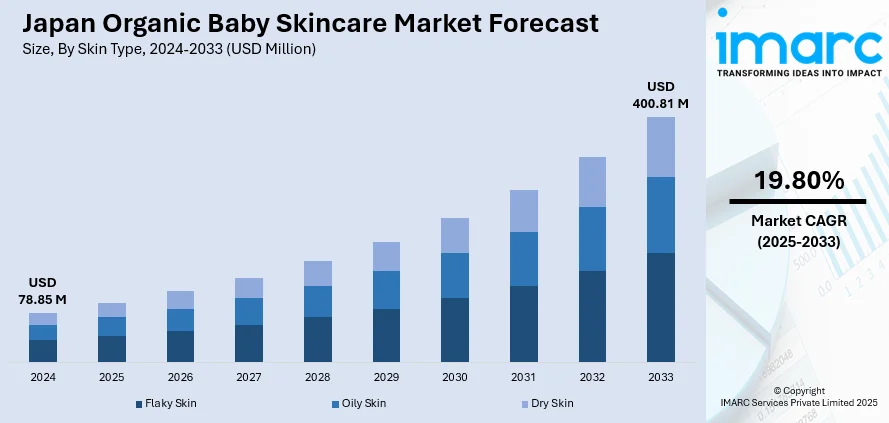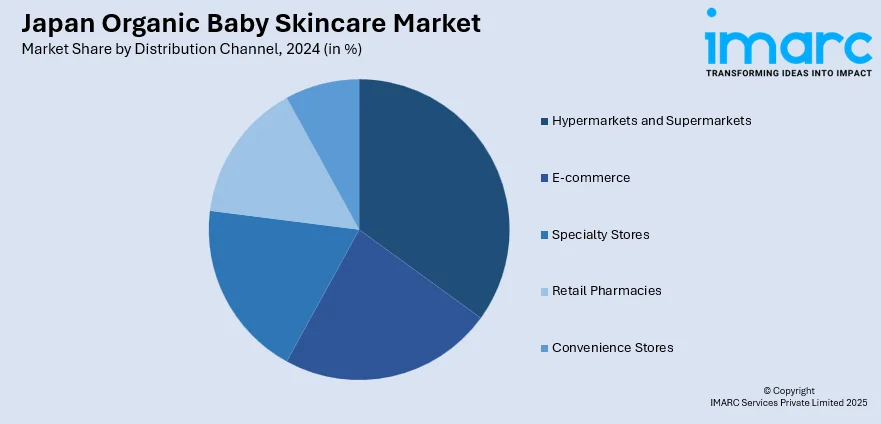
Japan Organic Baby Skincare Market Size, Share, Trends and Forecast by Skin Type, Product Type, Distribution Channel, and Region, 2025-2033
Japan Organic Baby Skincare Market Overview:
The Japan organic baby skincare market size reached USD 78.85 Million in 2024. Looking forward, IMARC Group expects the market to reach USD 400.81 Million by 2033, exhibiting a growth rate (CAGR) of 19.80% during 2025-2033. The market share is expanding, driven by the growing preferences for natural personal care items, along with the increasing influence of social media platforms, wherein influencers regularly share their experiences with new products.
|
Report Attribute
|
Key Statistics
|
|---|---|
|
Base Year
|
2024
|
|
Forecast Years
|
2025-2033
|
|
Historical Years
|
2019-2024
|
| Market Size in 2024 | USD 78.85 Million |
| Market Forecast in 2033 | USD 400.81 Million |
| Market Growth Rate 2025-2033 | 19.80% |
Japan Organic Baby Skincare Market Trends:
Increasing preferences for natural and organic personal care products
Rising preferences for natural and organic personal care items are fueling the Japan organic baby skincare market growth. Japanese people are showing concerns about the possible side effects of synthetic components, leading them to choose organic alternatives that are gentle on babies’ delicate skin. This shift aligns with a rise in disposable incomes, allowing people to afford premium and high-quality skincare products. In February 2025, the amount of disposable personal income in Japan reached 474,345 JPY. Parents seek transparency in item labeling, preferring products with certified organic ingredients and eco-friendly packaging. The rising trend of holistic wellness also reflects in baby care choices, where individuals value plant-based, dermatologically tested, and hypoallergenic formulations. Moreover, product innovations like organic baby balms, lotions, and shampoos enriched with natural oils and herbal extracts are gaining traction among new parents. Retailers and e-commerce platforms are responding by expanding their organic product ranges and improving accessibility. In addition, Japan's aging population with fewer children means parents tend to invest more in each child, reinforcing premium spending behavior. International brands are also entering the market, offering more variety and fostering competition.

Rising influence of social media
The growing influence of social media is offering a favorable Japan organic baby skincare market outlook. With a steady increase in social media users across all age groups, more people are engaging with content related to baby care, health, and wellness. According to the DataReportal, in January 2025, Japan had 97.0 Million social media user profiles, representing 78.6% of the entire population. Influencers, especially parenting bloggers and lifestyle creators, regularly share reviews and experiences with organic baby skincare products, which helps build trust and brand visibility. Social media platforms also allow brands to connect directly with people, promoting new product launches, ingredient benefits, and safe usage tips. Visual content highlighting natural ingredients, sustainable packaging, and gentle formulations appeals to health-conscious parents. Increasing user-generated content, such as testimonials, before-and-after photos, and unboxing videos, is creating a sense of community and reinforcing user confidence. In addition, targeted ads and sponsored content make it easier for niche organic brands to reach their ideal customers. As parents are seeking the best for their children, the influence of relatable and authentic content is encouraging them to try and adopt organic baby skincare items.
Japan Organic Baby Skincare Market Segmentation:
IMARC Group provides an analysis of the key trends in each segment of the market, along with forecasts at the country and regional level for 2025-2033. Our report has categorized the market based on skin type, product type, and distribution channel.
Skin Type Insights:
- Flaky Skin
- Oily Skin
- Dry Skin
The report has provided a detailed breakup and analysis of the market based on the skin type. This includes flaky skin, oily skin, and dry skin.
Product Type Insights:
- Baby Oil
- Baby Powder
- Baby Soaps
- Petroleum Jelly
- Baby Lotion
- Others
A detailed breakup and analysis of the market based on the product type have also been provided in the report. This includes baby oil, baby powder, baby soaps, petroleum jelly, baby lotion, and others.
Distribution Channel Insights:

- Hypermarkets and Supermarkets
- E-commerce
- Specialty Stores
- Retail Pharmacies
- Convenience Stores
The report has provided a detailed breakup and analysis of the market based on the distribution channel. This includes hypermarkets and supermarkets, e-commerce, specialty stores, retail pharmacies, and convenience stores.
Regional Insights:
- Kanto Region
- Kansai/Kinki Region
- Central/ Chubu Region
- Kyushu-Okinawa Region
- Tohoku Region
- Chugoku Region
- Hokkaido Region
- Shikoku Region
The report has also provided a comprehensive analysis of all the major regional markets, which include Kanto Region, Kansai/Kinki Region, Central/ Chubu Region, Kyushu-Okinawa Region, Tohoku Region, Chugoku Region, Hokkaido Region, and Shikoku Region.
Competitive Landscape:
The market research report has also provided a comprehensive analysis of the competitive landscape. Competitive analysis such as market structure, key player positioning, top winning strategies, competitive dashboard, and company evaluation quadrant has been covered in the report. Also, detailed profiles of all major companies have been provided.
Japan Organic Baby Skincare Market News:
- In October 2024, Shiseido Company, Limited teamed up with KitchHike Inc., Kakegawa City in Shizuoka Prefecture, and KODOMOLOGY Co., Ltd. to introduce a new service, “Preschool Exchange”1 at the Shiseido Kangaroom Kakegawa childcare center situated within the Shiseido Kakegawa Factory in Japan. The service enabled children to engage in a life focused on them within a vibrant natural setting. Families could indulge in a baby skincare experience. Kangaroom Kakegawa utilized Shiseido’s skincare items designed for infants for hydration and ultraviolet (UV) defense.
- In September 2024, SOLIA Corporation, based in Tokyo, launched a deeply moisturizing all-over cream, ‘Alobaby Body Cream,’ from its organic baby skin care line, Alobaby. It was composed of more than 99% natural ingredients and was free from additives, ensuring it was gentle on delicate baby skin while effectively soothing the face and entire body.
Japan Organic Baby Skincare Market Report Coverage:
| Report Features | Details |
|---|---|
| Base Year of the Analysis | 2024 |
| Historical Period | 2019-2024 |
| Forecast Period | 2025-2033 |
| Units | Million USD |
| Scope of the Report |
Exploration of Historical Trends and Market Outlook, Industry Catalysts and Challenges, Segment-Wise Historical and Future Market Assessment:
|
| Skin Types Covered | Flaky Skin, Oily Skin, Dry Skin |
| Product Types Covered | Baby Oil, Baby Powder, Baby Soaps, Petroleum Jelly, Baby Lotion, Others |
| Distribution Channels Covered | Hypermarkets and Supermarkets, E-commerce, Specialty Stores, Retail Pharmacies, Convenience Stores |
| Regions Covered | Kanto Region, Kansai/Kinki Region, Central/ Chubu Region, Kyushu-Okinawa Region, Tohoku Region, Chugoku Region, Hokkaido Region, Shikoku Region |
| Customization Scope | 10% Free Customization |
| Post-Sale Analyst Support | 10-12 Weeks |
| Delivery Format | PDF and Excel through Email (We can also provide the editable version of the report in PPT/Word format on special request) |
Key Questions Answered in This Report:
- How has the Japan organic baby skincare market performed so far and how will it perform in the coming years?
- What is the breakup of the Japan organic baby skincare market on the basis of skin type?
- What is the breakup of the Japan organic baby skincare market on the basis of product type?
- What is the breakup of the Japan organic baby skincare market on the basis of distribution channel?
- What is the breakup of the Japan organic baby skincare market on the basis of region?
- What are the various stages in the value chain of the Japan organic baby skincare market?
- What are the key driving factors and challenges in the Japan organic baby skincare?
- What is the structure of the Japan organic baby skincare market and who are the key players?
- What is the degree of competition in the Japan organic baby skincare market?
Key Benefits for Stakeholders:
- IMARC’s industry report offers a comprehensive quantitative analysis of various market segments, historical and current market trends, the Japan organic baby skincare market forecast, and dynamics from 2019-2033.
- The research report provides the latest information on the market drivers, challenges, and opportunities in the Japan organic baby skincare market.
- Porter's five forces analysis assist stakeholders in assessing the impact of new entrants, competitive rivalry, supplier power, buyer power, and the threat of substitution. It helps stakeholders to analyze the level of competition within the Japan organic baby skincare industry and its attractiveness.
- Competitive landscape allows stakeholders to understand their competitive environment and provides an insight into the current positions of key players in the market.
Need more help?
- Speak to our experienced analysts for insights on the current market scenarios.
- Include additional segments and countries to customize the report as per your requirement.
- Gain an unparalleled competitive advantage in your domain by understanding how to utilize the report and positively impacting your operations and revenue.
- For further assistance, please connect with our analysts.
 Request Customization
Request Customization
 Speak to an Analyst
Speak to an Analyst
 Request Brochure
Request Brochure
 Inquire Before Buying
Inquire Before Buying




.webp)




.webp)












